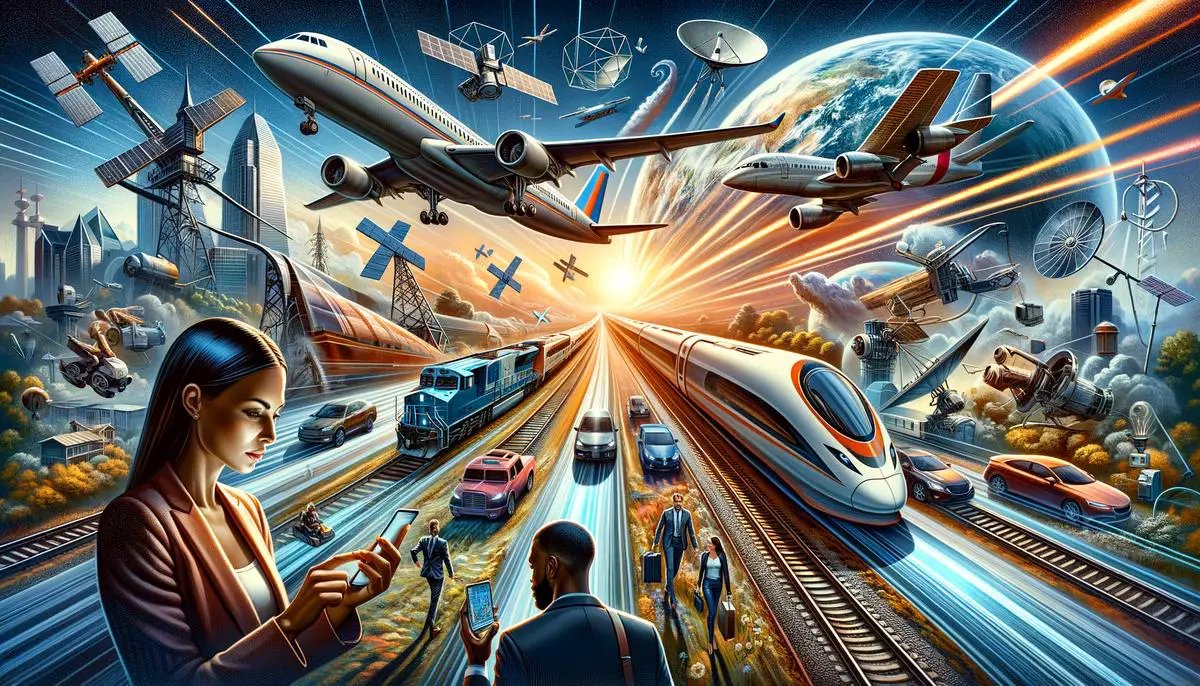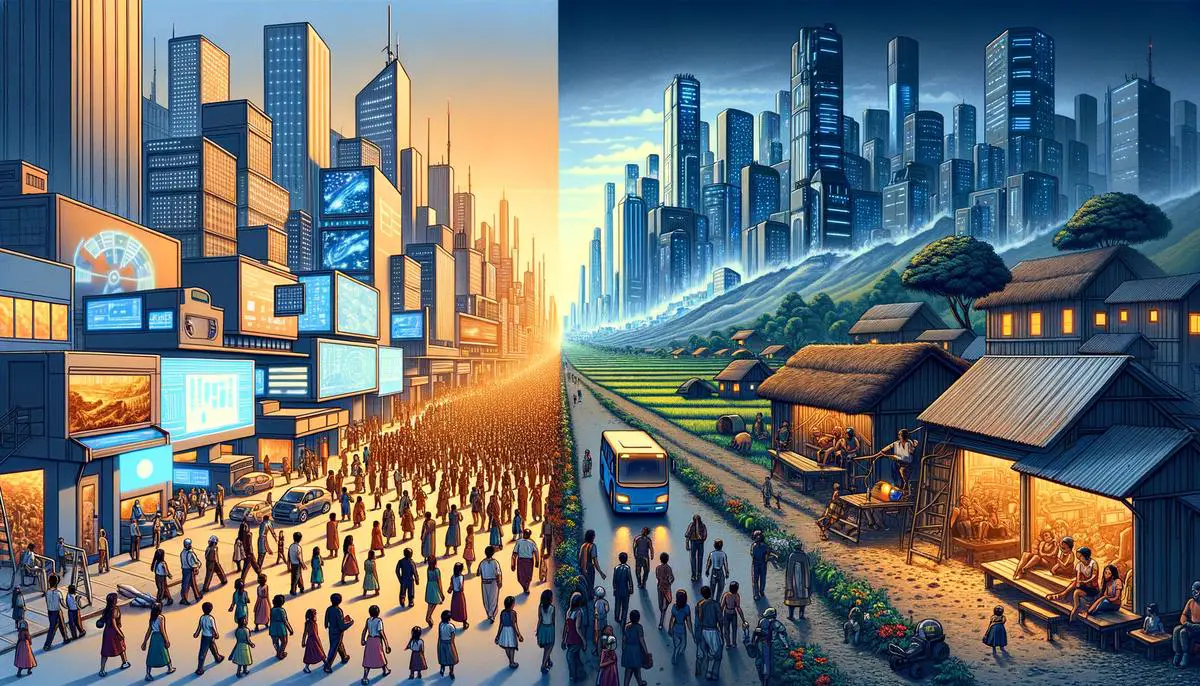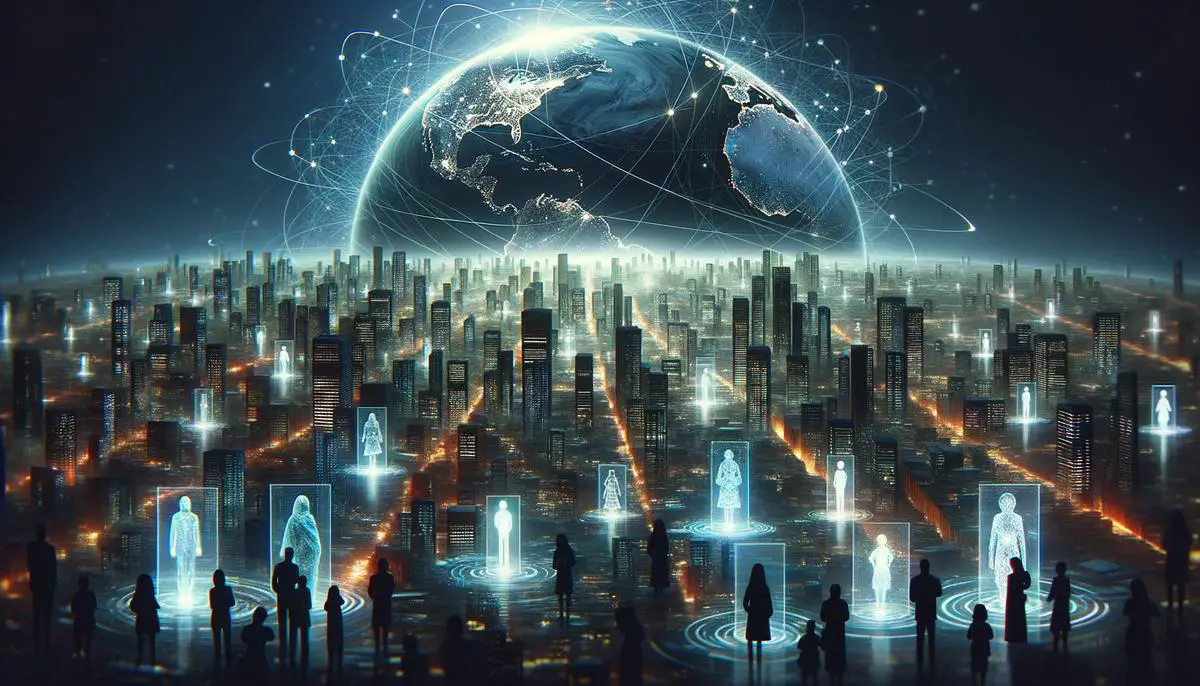Space-time compression is a concept that has reshaped our understanding of distance and connectivity in the modern world. By examining the advancements in transportation, communication, and technology, we can see how these changes have brought distant places closer together, influencing our social and economic landscapes.
Definition and Historical Context
Space-time compression refers to a phenomenon where the world's apparent size shrinks due to advancements in transportation, communication, and the flows of capital and people. This concept emerged as a consequence of globalization, connecting distant places more closely.
Karl Marx first observed that technological developments increasingly reduced the constraints of space, accelerating the movement of goods, people, and information. David Harvey later built upon Marx's idea in his 1989 book, The Condition of Postmodernity. Harvey connected space-time compression with capitalism, arguing that it sped up economic processes and disrupted human lives.
Harvey's analysis noted that as technology and transportation improved, the movement of capital became faster, reducing the significance of space and increasing the pace of life. He pointed out that this phenomenon had uneven effects, valuing some places more than others and even causing certain areas to lose their identities in the age of post-Fordism.
Examples of Space-Time Compression:
- Traveling across oceans in a day instead of months
- Making instant global phone calls
- Real-time video conferencing with people worldwide
Critics like Doreen Massey argue that space-time compression is experienced unevenly. Some people benefit more than others due to factors like location, income, and access to technology, making the concept not universally applicable. Massey highlights that these varying experiences mean that space-time compression must be socially differentiated.

Mechanisms and Examples
The primary mechanisms behind space-time compression include advancements in transportation, communication, and digital technology. Each of these elements has played a crucial role in reducing the perceived distances between different parts of the world.
Key Mechanisms:
- Transportation: The advent of jet planes has drastically altered the way we perceive distance. A journey from the United Kingdom to Australia that once took months by sea can now be completed in under 24 hours. High-speed rail networks and improvements in automobile technology have also contributed to shrinking travel times.
- Communication Technology: The internet allows for instant communication, enabling real-time interactions regardless of physical location. Mobile phones have revolutionized connectivity, allowing us to communicate with someone halfway across the globe as easily as if they were in the same room.
- Digital Technology: Global positioning systems (GPS) and advancements in geospatial technologies offer real-time location tracking and navigation. This technology has transformed personal travel and revolutionized logistics and supply chain management, allowing goods to be tracked and delivered across continents with unparalleled precision and speed.
While the benefits of these advancements are significant, it's essential to recognize their uneven distribution. In many parts of the world, access to high-speed internet and advanced transportation remains limited, leading to a disparity in the experience of space-time compression. This digital divide highlights that while some regions and populations are well-integrated into the global network, others remain isolated.

Impact on Capitalism and Globalization
The acceleration in the movement of capital, driven by technological advancements and globalization, has led to the rapid circulation of goods, services, and information. This has engineered a faster-paced social life, minimizing the significance of location and deepening economic interdependencies across the globe.
Contemporary corporations operate on just-in-time production models, where resources and products are manufactured and delivered as needed, drastically reducing storage and warehousing costs. Businesses can now source raw materials from one continent, assemble products in another, and distribute them worldwide, all within a remarkably compressed timeframe.
"Online shopping platforms like Amazon epitomize the speed of modern consumerism. The ability to order a product from anywhere in the world with just a few clicks and have it delivered within days underscores the reduced importance of physical distance in consumer transactions."
The impact of space-time compression on the significance of place is another critical facet. In a globalized economy, certain locations become highly valued, often transforming into bustling hubs of economic activity, while others may face economic decline. Major financial centers like New York, London, and Tokyo attract vast amounts of capital and talent due to their strategic importance in the global economic network. Conversely, regions that once thrived under localized economic models may struggle to adapt, leading to phenomena like deindustrialization and economic displacement.
This uneven development highlights the dual nature of space-time compression. While it has facilitated unprecedented economic growth and interconnectedness, it has also exacerbated inequalities both within and between countries. Wealth and opportunities tend to concentrate in areas that can best leverage technological and infrastructural advancements, while other areas may experience marginalization.
Communities that have undergone significant restructuring due to the pressures of global capitalism often face challenges in maintaining their cultural identities and social cohesion. The displacement of traditional industries, the influx of multinational corporations, and the transformation of urban landscapes can lead to a sense of alienation and loss of place among residents.
Despite these challenges, the interconnected nature of our modern world also presents opportunities for fostering more sustainable and inclusive economic models. By acknowledging and addressing the disparities brought about by space-time compression, there is potential to create policies and practices that promote equitable growth. Initiatives that focus on digital inclusion, sustainable urban planning, and the decentralization of economic activities can help mitigate the adverse effects of rapid globalization and ensure that the benefits of space-time compression are more evenly distributed.
Critiques and Disadvantages
Doreen Massey offers a compelling critique that explores the limitations and biases inherent in the concept of space-time compression. She argues that the original framing is heavily Eurocentric, focusing predominantly on the experiences and contexts of the Western world. This perspective often overlooks the varied and nuanced ways in which different regions and communities experience these changes.
Massey emphasizes that the theory does not account for the varying experiences of individuals based on their socio-economic status, race, gender, and geographic location. For example, the differences in travel experiences between a jet-setting executive and an undocumented migrant highlight the uneven nature of global mobility. Similarly, rural communities often lack the infrastructure and resources to participate fully in the globalized economy, leading to a sense of exclusion and marginalization.
This uneven experience extends to the digital realm as well. Access to advanced communication technologies, such as smartphones and high-speed internet, is unequal. While urban centers in developed countries may enjoy ubiquitous connectivity, remote and impoverished areas often remain disconnected. This digital divide perpetuates inequalities, as those without access are left out of the economic, educational, and social opportunities that the digital age provides.
Key Critiques:
- Potential loss of local identities and cultures
- Exacerbation of socio-economic inequalities
- Uneven distribution of benefits and challenges
- Homogenization of cultural landscapes
These critiques underscore that space-time compression is not an inherently positive or negative phenomenon but a complex and multifaceted process. It brings both opportunities and challenges, and its impacts are unevenly distributed. For space-time compression to contribute to a more equitable world, there must be a concerted effort to address these disparities. Policies that promote digital inclusion, equitable development, and the preservation of local cultures are essential to ensuring that the benefits of globalization are shared more broadly.
By acknowledging the limitations and biases of the original theory, we can develop more inclusive frameworks that better reflect the realities of our interconnected world. This approach enriches our understanding and guides us towards more equitable and sustainable global development.

Time-Space Compression vs. Convergence
Time-space compression and time-space convergence, while related, address different aspects of our changing world:
- Time-space convergence: Focuses on the reduction in travel time between locations due to advancements in transportation and communication technologies.
- Time-space compression: A broader concept encompassing the social, economic, and cultural impacts of shrinking distances.
Time-space convergence effectively "shrinks" spatial distances through faster means of transportation such as high-speed trains, airplanes, and emerging technologies like hyperloops. On the other hand, time-space compression explores how the increased speed of communication and capital flow reshapes our lives, economies, and societies at a fundamental level.
For example:
- Time-space convergence: Use of high-speed rail networks to cut down travel time between major cities.
- Time-space compression: Examination of how this reduction influences economic opportunities, residential patterns, and social interactions across these regions.
The internet and mobile phones contribute to both phenomena:
- Convergence: Allowing instant communication
- Compression: Transforming daily life by blurring boundaries between work and personal time, reshaping societal norms and expectations
It's crucial to understand how these dynamics impact cultural experiences. While time-space convergence makes it possible for someone to travel from one cultural hub to another in a matter of hours, time-space compression looks at how this increased interaction affects cultural identity, potentially leading to homogenization as global trends interact with local traditions.
By understanding these nuances, we gain a more comprehensive view of how technological advancements reshape human experiences. This fuller picture underscores the importance of thoughtful policy-making and planning to ensure these advancements benefit society equitably, supporting both efficient movement across space and the rich, diverse mosaic of human culture and social experience.

Future Implications and Research
The future of space-time compression promises both exciting advancements and formidable challenges. As technology continues to evolve, the pace at which we experience the world will likely accelerate, further transforming how we interact with our surroundings.
Potential Innovations:
- Transportation: Hyperloop systems, electric and autonomous vehicles
- Communication: Quantum computing, 5G networks
These advancements could revolutionize intercity travel, enhance urban connectivity, and lead to breakthroughs in global data-sharing and telecommunication.
Challenges:
- Exacerbation of socio-economic inequalities
- Digital divide
- Increased surveillance and data privacy concerns
To address these challenges, we need:
- Concerted efforts to ensure equitable access to technological advancements
- Strong legal frameworks
- Advancements in cybersecurity
Further research is needed to develop more formal modeling frameworks for understanding space-time compression. Agent-based models, time-geography approaches, and dynamic systems could offer deeper insights into how space-time dynamics influence social, economic, and cultural experiences.
"The impact of emerging technologies like artificial intelligence and blockchain on space-time compression also needs exploration. These technologies have the potential to optimize logistics, enhance real-time decision-making, and revolutionize supply chains and financial transactions."
The push for sustainable development intersects with future implications of space-time compression. Developing green technologies and promoting sustainable practices in the face of rapid globalization will be critical for ensuring a balanced approach to progress.
In conclusion, the future of space-time compression is poised to bring about transformative changes. By addressing the challenges and harnessing the potential of new technologies, we can strive for a future that is not only more interconnected but also more equitable and sustainable. Research and policy must work together to address this evolving landscape, ensuring that the benefits of space-time compression are realized for all, while safeguarding against its potential pitfalls.
The most important takeaway from space-time compression is its profound impact on our interconnected world. As we continue to advance technologically, it's crucial to address the disparities and challenges that arise, striving for a more inclusive and equitable global society.
![]()
